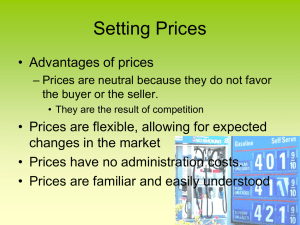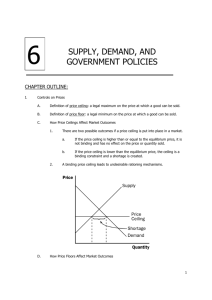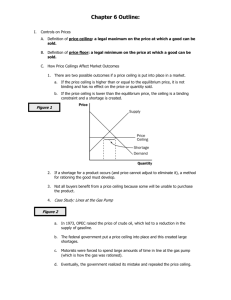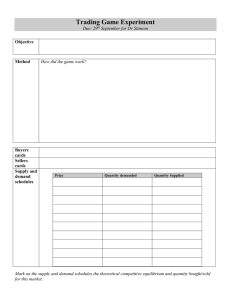6 Supply, Demand, and Government Policies Chapter
advertisement
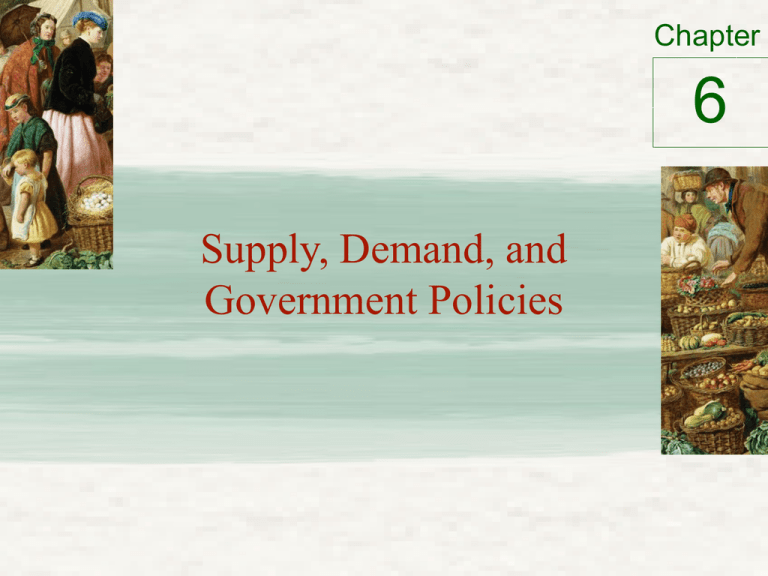
Chapter 6 Supply, Demand, and Government Policies Controls on Prices • How price ceilings affect market outcomes – Price ceiling • Legal maximum on the price at which a good can be sold • Not binding – Above the equilibrium price – No effect • Binding constraint – Below the equilibrium price – Shortage – Sellers must ration the scarce goods » The rationing mechanisms – not desirable 2 Figure 1 A market with a price ceiling (a) A price ceiling that is not binding Price of Ice Cream Cones (b) A price ceiling that is binding Price of Ice Cream Cones Supply Supply Price ceiling $4 Equilibrium price $3 3 Equilibrium price Price ceiling 2 Demand Shortage Quantity supplied Equilibrium quantity 0 100 Quantity of Ice-Cream Cones 0 Demand Quantity demanded 125 75 Quantity of Ice-Cream Cones In panel (a), the government imposes a price ceiling of $4. Because the price ceiling is above the equilibrium price of $3, the price ceiling has no effect, and the market can reach the equilibrium of supply and demand. In this equilibrium, quantity supplied and quantity demanded both equal 100 cones. In panel (b), the government imposes a price ceiling of $2. Because the price ceiling is below the equilibrium price of $3, the market price equals $2. At this price, 125 cones are 3 demanded and only 75 are supplied, so there is a shortage of 50 cones. Lines at the gas pump • 1973, OPEC raised the price of crude oil – Reduced the supply of gasoline – Long lines at gas stations • What was responsible for the long gas lines? – OPEC: created shortage of gasoline – U.S. government regulations: price ceiling on gasoline • Before OPEC raised the price of crude oil – Equilibrium price - below price ceiling: no effect • When the price of crude oil rose – Reduced the supply of gasoline – Equilibrium price – above price ceiling: shortage 4 Figure 2 The market for gasoline with a price ceiling (a) The price ceiling on gasoline is not binding Price of (b) The price ceiling on gasoline Price of is binding Gasoline Gasoline S2 1. Initially, the price ceiling is not binding … Supply, S1 S1 P2 Price ceiling Price ceiling 3…the price ceiling becomes binding… P1 P1 4. …resulting in a shortage Demand Demand 0 Q1 Quantity of Gasoline 2…but when supply falls… 0 QS QD Q1 Quantity of Gasoline Panel (a) shows the gasoline market when the price ceiling is not binding because the equilibrium price, P1, is below the ceiling. Panel (b) shows the gasoline market after an increase in the price of crude oil (an input into making gasoline) shifts the supply curve to the left from S 1 to S2. In an unregulated market, the price would have risen from P1 to P2. The price ceiling, however, prevents this from happening. At the binding price ceiling, consumers are willing to buy Q D, but producers of gasoline are willing to sell only Q S. The difference between quantity demanded and quantity supplied, Q D – QS, measures the gasoline 5 shortage. Controls on Prices • How price floors affect market outcomes – Price floor • Legal minimum on the price at which a good can be sold • Not binding – Below the equilibrium price – No effect • Binding constraint – Above the equilibrium price – Surplus – Some seller are unable to sell what they want » The rationing mechanisms – not desirable 6 Figure 4 A market with a price floor Price of Ice Cream Cone (a) A price floor that is not binding Supply Price of Ice Cream Cone $4 (b) A price floor that is binding Surplus Supply Price floor 3 $3 Equilibrium price 2 Equilibrium price Price floor Demand Demand Quantity demanded Equilibrium quantity 0 100 Quantity of Ice-Cream Cones 0 Quantity supplied 120 80 Quantity of Ice-Cream Cones In panel (a), the government imposes a price floor of $2. Because this is below the equilibrium price of $3, the price floor has no effect. The market price adjusts to balance supply and demand. At the equilibrium, quantity supplied and quantity demanded both equal 100 cones. In panel (b), the government imposes a price floor of $4, which is above the equilibrium price of $3. Therefore, the market price equals $4. Because 120 cones are supplied at this price and 7 only 80 are demanded, there is a surplus of 40 cones. The minimum wage • Price floor: minimum wage – Lowest price for labor that any employer may pay • Fair Labor Standards Act of 1938 – Ensure workers a minimally adequate standard of living • 2007: minimum wage = $5.15 per hour – Scheduled to increase to $7.25 by 2010 8 The minimum wage • Market for labor – Workers - supply of labor – Firms – demand for labor • If minimum wage – above equilibrium – Unemployment – Higher income - workers who have jobs – Lower income - workers who cannot find jobs 9 The minimum wage • Impact of the minimum wage – Workers with high skills and much experience • Not affected: Equilibrium wages - above the minimum • Minimum wage - not binding – Teenage labor – least skilled and least experienced • Low equilibrium wages • Willing to accept a lower wage in exchange for on-the-job training • Minimum wage – binding 10 Figure 5 How the minimum wage affects the labor market (a) A free labor market (b) A Labor Market with a Binding Minimum Wage Wage Wage Labor supply Labor surplus (unemployment) Minimum wage Equilibrium wage Labor demand Labor demand 0 Labor supply Equilibrium employment Quantity of Labor 0 Quantity demanded Quantity Quantity supplied of Labor Panel (a) shows a labor market in which the wage adjusts to balance labor supply and labor demand. Panel (b) shows the impact of a binding minimum wage. Because the minimum wage is a price floor, it causes a surplus: The quantity of labor supplied exceeds the quantity demanded. 11 The result is unemployment. Figure 6 A tax on sellers Price of Ice-Cream Cone Price buyers pay Price without tax Equilibrium with tax S2 S1 A tax on sellers shifts the supply curve upward by the size of the tax ($0.50). $3.30 Tax ($0.50) 3.00 Equilibrium without tax 2.80 Price sellers receive Demand, D1 0 90 100 Quantity of Ice-Cream Cones When a tax of $0.50 is levied on sellers, the supply curve shifts up by $0.50 from S 1 to S2. The equilibrium quantity falls from 100 to 90 cones. The price that buyers pay rises from $3.00 to $3.30. The price that sellers receive (after paying the tax) falls from $3.00 to $2.80. Even though 12 the tax is levied on sellers, buyers and sellers share the burden of the tax. Taxes • How taxes on sellers affect market outcomes – Taxes discourage market activity – Smaller quantity sold – Buyers and sellers share the burden of tax – Buyers pay more • Worse off – Sellers receive less • Get the higher price but pay the tax • Overall: effective price fall • Worse off 13 Taxes • How taxes on buyers affect market outcomes – Initial impact on the demand – Demand curve shifts left – Lower equilibrium price – Lower equilibrium quantity – The tax – reduces the size of the market 14 Figure 7 A tax on buyers Price of Ice-Cream Cone Price buyers pay Price without tax Equilibrium with tax Supply, S1 Equilibrium without tax $3.30 A tax on buyers shifts the demand curve downward by the size of the tax ($0.50). Tax ($0.50) 3.00 2.80 Price sellers receive D1 D2 0 90 100 Quantity of Ice-Cream Cones When a tax of $0.50 is levied on buyers, the demand curve shifts down by $0.50 from D1 to D2. The equilibrium quantity falls from 100 to 90 cones. The price that sellers receive falls from $3.00 to $2.80. The price that buyers pay (including the tax) rises from $3.00 to $3.30. Even though the 15 tax is levied on buyers, buyers and sellers share the burden of the tax. Taxes • How taxes on buyers affect market outcomes – Buyers and sellers share the burden of the tax – Sellers get a lower price • Worse off – Buyers pay a lower market price • Effective price (with tax) rises • Worse off • Taxes levied on sellers and taxes levied on buyers are equivalent 16 Can congress distribute the burden of a payroll tax? • Payroll taxes – Deducted from the amount you earned • By law, the tax burden: – Half of the tax - paid by firms • Out of firm’s revenue – Half of the tax - paid by workers • Deducted from workers’ paychecks • Tax incidence analysis – Payroll tax = tax on a good • Good = labor • Price = wage 17 Can congress distribute the burden of a payroll tax? • Introduce payroll tax – Wage received by workers falls – Wage paid by firms rises – Workers and firms share the burden of the tax • Not necessarily fifty-fifty as the legislation requires • Lawmakers – Can decide whether a tax comes from the buyer’s pocket or from the seller’s – Cannot legislate the true burden of a tax • Tax incidence: forces of supply and demand 18 Figure 8 A payroll tax Wage Labor supply Wage firms pay Tax wedge Wage without tax Wage workers receive Labor demand 0 Quantity of Labor A payroll tax places a wedge between the wage that workers receive and the wage that firms pay. Comparing wages with and without the tax, you can see that workers and firms share the tax burden. This division of the tax burden between workers and firms does not depend on whether the government levies the tax on workers, levies the tax on firms, or divides the tax equally 19 between the two groups. Taxes • Elasticity and tax incidence • Dividing the tax burden – Very elastic supply and relatively inelastic demand • Sellers – small burden of tax • Buyers – most of the burden – Relatively inelastic supply and very elastic demand • Sellers – most of the tax burden • Buyers – small burden 20 Figure 9 How the burden of a tax is divided (a) (a) Elastic Supply, Inelastic Demand Price 1. When supply is more elastic than demand . . . Supply Price buyers pay Tax Price without tax Price sellers receive 2. . . . The incidence of the tax falls more heavily on consumers . . . 3. . . . Than on producers. Demand 0 Quantity In panel (a), the supply curve is elastic, and the demand curve is inelastic. In this case, the price received by sellers falls only slightly, while the price paid by buyers rises substantially. Thus, 21 buyers bear most of the burden of the tax. Figure 9 How the burden of a tax is divided (b) (b) Inelastic Supply, Elastic Demand Price 1. When demand is more elastic than supply . . . Supply Price buyers pay Price without tax 3. Than on consumers Tax Demand 2. . . . The incidence of the tax falls more heavily on producers. Price sellers receive 0 Quantity In panel (b), the supply curve is inelastic, and the demand curve is elastic. In this case, the price received by sellers falls substantially, while the price paid by buyers rises only slightly. Thus, 22 sellers bear most of the burden of the tax. Taxes • Tax burden - falls more heavily on the side of the market that is less elastic – Small elasticity of demand • Buyers do not have good alternatives to consuming this good – Small elasticity of supply • Sellers do not have good alternatives to producing this good 23 Who pays the luxury tax? • 1990 - new luxury tax – Goal: to raise revenue from those who could most easily afford to pay – Luxury items • Demand - quite elastic • Supply - relatively inelastic • Outcome: – Burden of a tax falls largely on the suppliers • 1993 – most of the luxury tax – repealed 24
